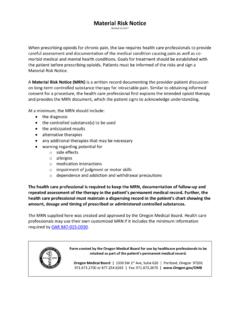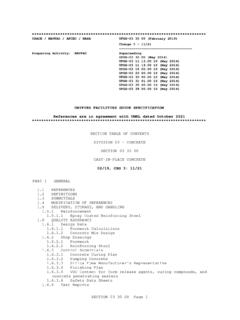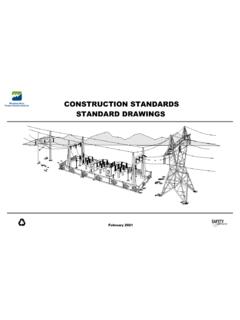Transcription of Artifact Idea Chart - Oregon
1 Artifact Idea Chart for Danielson Framework in David Douglas School District As part of the Teacher Growth and Evaluation system, teachers and administrators are asked to collect evidence and artifacts to support their ratings on the self-assessment and summative evaluation forms. Evidence: noun the available body of facts or information indicating whether a belief or proposition is true or valid signs; indications Artifact : noun an object made by a human being, typically an item of cultural or historical interest something observed in a scientific investigation or experiment that is not naturally present but occurs as a result of the preparative or investigative procedure When is an administrator required to provide evidence to support their ratings? 1. There must be documented evidence or an Artifact for a teacher to be ranked Exemplary on a teaching standard. 2. Any area that is identified as Unsatisfactory, the administrator/evaluator will provide documented evidence or artifacts .
2 When is a teacher required to provide evidence or an Artifact to support their ratings? 1. Any area in which you identify yourself as Exemplary, you must submit evidence or artifacts on the evidence documentation sheet (upload to Talent Ed). 2. If a teacher disagrees with the rating of an administrator/evaluator they will provide documented evidence or artifacts to support their claim. Artifact Idea Chart for Danielson Framework in David Douglas School District 1a. Demonstrating Knowledge of Content and Pedagogy Learning targets aligned to standards posted and used in classroom Curriculum differentiation- appropriate level Collaborative and independent lessons/activities (different learning styles) Lesson plans including a diversity of activities Lesson plans reflect standards, current practices, and adopted curriculum 1b. Demonstrating Knowledge of Students Examples of modified tasks Seating Chart to demonstrate knowledge of IEP or other needs Differentiated lessons/tasks Lesson plans that demonstrate understanding of learning styles Behavior management plan that demonstrates understanding of personality and interaction styles Behavior tracking forms Home visits communication logs email/phone calls Student surveys Notes about individual student strengths and challenges Use of synergy reports w/ reflection on date Partner/grouping list based on student data Record/log of attendance of extracurricular events 1c.
3 Setting Instructional Outcomes Learning Targets posted lesson objectives clearly communicated in the lesson plan Student goals individual student self-- assessments Reflecting and adjusting instruction as necessary based on the following: formative assessments, observations, check- ins, e t c. Lessons reflect pretest data and learning goal Plans that show alignment of standards and curriculum Curriculum map that lists standards connected to lessons Individual and PLT SMART goals and baseline data Creating a cohesive/streamlined tiered system of outcomes Examples of tiered tasks 1d. Demonstrating Knowledge of Resources Invitations, notes, video for guest speaker Documentation of curriculum adoption committee or training Assignment sheet w/ resource list Teacher website with links Field trips documentation of connection to learning targets and standards Using TOSAs and other specialist (calendars, emails, conversation logs) Documentation of use of online resources: IXL, Discovery Ed assignments, etc.
4 PLT documentation of shared resources (common assessments, shared strategies) Appropriate leveled texts lists (classroom library list, picture of leveled library) Utilized peers and administrators (specialists, librarian, IT) - document Documentation of connections of curriculum resources adopted core, intervention, supplemental, etc. 1e. Designing Coherent Instruction Course calendars- pacing guide (building blocks- chunks) Unit outlines Lesson plans connected to standards Gradual release of responsibility - to, with, by Assessments Lists of flexible learning groups Differentiated lessons Collaborative learning activities for students Observations from evaluator/peer learning walks Student success on goals (data, self-assessment, reflection) Sentence frames included in lessons Present information using visuals, speaking, audio Explicit vocabulary - academic language, mortar Vertical and/or horizontal progressions of learning 1f. Designing Student Assessments Using/accessing district assessments Assessment samples Variety of format for opportunities (paper/pencil, student- teacher interview, observation, project skill demonstration, technology, etc.)
5 Assessment rubrics reflecting levels of proficiency Different styles of questions (multiple choice, open ended, essay, performance tasks) Use of baseline data to design assessments Demonstration of ongoing assessment Pre/formative/post assessments for same concept Artifact Idea Chart for Danielson Framework in David Douglas School District 2a. Creating an Environment of Respect and Rapport Pictures of goals, norms, classroom posters (PBIS) Examples of whole class positive reinforcement (compliment jar, class points, etc.) Examples and non-- examples for how to interact with others in the room (T-- Chart , video role play) Photos of students following expectations (example: wearing goggles in a lab) Class feedback surveys (Do you feel safe in class?, Do you feel respected?) Seating Chart with notes about cooperative groups 2b. Establishing a culture for Learning Classroom expectation charts and Universal expectation posters (PBIS) Academic Language posted Posting goals/ strategies/ focus skills/learning targets Photo of materials station to support learning Student work displayed Course syllabus Entrance routine expectations Bell Work Teacher/student conferencing notes Documentation of management/procedures Posted expectations for working in cooperative groups Lesson plans with engagement strategies included 2c.
6 Managing Classroom Procedures Jobs charts/ student jobs Lessons on how to do everyday activities/routines Photos of materials and supplies prepared in advance Posted matrix (classroom expectation charts for transitions/work time) Role plays (videoed) Make-- up assignment notebooks/files (system) Posted schedules Documentation of transition signals or procedures Noise/ level scale posted Attendance records Assistant/volunteer schedules and plans 2d. Managing Student Behaviors Leveled behavior system in classrooms (clip charts, card system) Behavior plan FBA/BSP for student with notes about implementation Behavior expectations and consequences posted Data for students - # of minors/ referrals for particular behaviors lessons for addressing problem areas Home/ School Communication log reinforcement system (incentives) Check in check out (CICO) Online behavior management (Class Dojo reports) Individual contracts 2e. Organizing Physical Space Materials and teacher tools stored in organized and secure manner (photo) Layout of room (photo) space organized and user friendly easy to move around and get to all students, safe, easy access to resources Photos of room show easy student access to materials and learning spaces.
7 Seating charts Fire safety plan posted Assignment turn-- in baskets Traffic pattern plans for teaching and for student movement Artifact Idea Chart for Danielson Framework in David Douglas School District 3a. Communicating with students Timely and clear written feedback to students (personal/academic/skill related) Technology created emails/notes/reminders (Synergy, Remind 101) Anchor Chart /Sentence Frames Student Conference time sheets/notes Keeping synergy up to date (studentvue/parentvue) Student conferencing notes White board instructions (photo) Data collection from mini/formal observation Learning targets posted Class website Interviews students-- do they know targets? Student surveys 3b. Using Questioning and Discussion Techniques Power point slides w/ discussion questions that promote metacognition Engagement strategies documented in lesson plans Academic sentence frames provided for small group/ whole class discussion Observation feedback Record of the types of questions that not only teachers are asking students, but students are asking each other Using discussion forums online (edmodo) Student work samples Examples of student response journaling 3c.
8 Engaging Students in Learning Engagement strategies documented in lesson plans Videos of high engagement activities Administrator/ Peer notes on classroom observations of engagement strategies Student created assessments/problems Documentation of ELD Routines utilized with notes about student participation/success Tally student participation (variety? Volunteer, cold call) Students graph own data/ keep track of progress Use of menus to provide student choice 3d. Using Assessment in Instruction Ongoing assessment and strategy modification based on the analysis of data Examples of varying assessment styles (quiz, oral, conference, project, test, etc.) Rubrics Exit slips/ target checks/ self-- assessments Video of lesson using check in systems during lessons to gage students understanding (ex. Thumb up/down, partner/sharing) Differentiation plans based on pre-- assessment 3e. Demonstrating Flexibility and Responsiveness Differentiated lesson plans based on data, student needs and interests Use of menus to provide student choice Notes from admin or peer observation about making changes based on student response.
9 Variety of media/resources used to address need Artifact Idea Chart for Danielson Framework in David Douglas School District 4a. Reflecting on Teaching Mid year review conference document PLT notes with reflection on future goals and growth Lesson plans w/ reflection at end Meeting notes with peers to reflect on lessons Collaboration notes Record of post peer observation debrief conference Coaching log Reflection journal 4b. Maintaining Accurate Records ( artifacts that show PROFICIENCY) Grade book Conferencing notes Data tacking sheet/system PLT data - SMART goal/data points Forms - field trip, health information, class fee Behavior notes and data Missing/turned in classwork record Attendance log Collecting minor incident data Guest teacher folders Students graph own data/ keep track of progress (Use to document exemplary) 4c. Communicating with Families ( artifacts that show PROFICIENCY) Copy of class newsletter/ parent communication tools (translate to languages exemplary) Parent communication log Course syllabus Positive notes home Emails to parents Notes from Parent/ teacher conferences Report card comments Progress reports with comments Missing work reports Class Dojo reports Student led newsletter (Use to document exemplary) School home projects designed by the student (Use to document exemplary) 4d.
10 Participating in a Professional Community PLT and/or collaboration facilitator s meeting notes and agendas Documentation of leadership on a district, school, and/or community committee Presenting in staff meeting Model teacher for peer observation (ex. Notes, feedback, ) Mentoring student teachers Participation in school/community activities outside the work day Active participation in professional organizations Attendance at PTA/PTO meetings Attendance at School Board meetings 4e. Growing and Developing Professionally Certificate of completion @ workshop PDU Log Endorsements/new programs (endorsements, masters, doctoral) Documentation of additional leadership responsibilities Participation in staff book studies Participating in professional learning critical friends group Peer-- observation with feedback documentation Visitations to other classrooms/schools Action research Publishing in professional journals or websites Membership/ leadership in professional organization Collaborating with peers reflection notes National Board Certification 4f.















